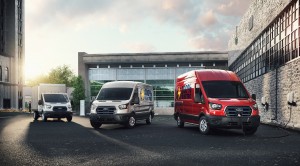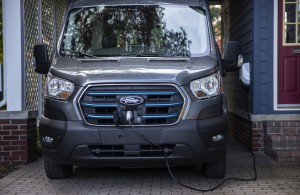

The most remarkable thing about driving the Ford e-Transit is that there is nothing remarkable about it at all. It drives just like an ICE Transit, only better.
You get in, buckle up, push the start button and nothing happens. No engine starter noise, no engine noise, no cooling fan noise, no nothing. Then you turn the rotary shift indicator to D and drive away. That’s it.
It rides better an ICE version thanks to an independent rear suspension, and it’s quieter but not by much. That’s because I drove a long wheelbase, high roof Transit, which is a big, tall, empty, steel box that has a lot of boom, resonance and road noise.

On other electric vehicles you can select more aggressive regenerative braking though the center screen, by shifting into Low, or by using a steering wheel paddle. On the eTransit you can tap the brakes once or even a second time to get progressively more re-gen. Once you get back on the accelerator, it reverts back to low re-gen. That’s a nice intuitive way to trigger more re-gen.
I very much wanted to use the Pro Power option that Ford offers, where you can plug the van into your house and run your house with electricity from the battery. But that’s not available on the E-Transit.

Unlike other electric cars, the e-Transit is not particularly quick off the line. Yes, you get that instant torque, but Ford tuned this commercial van to deliver packages—not to deliver fast 0-to-60 mph times.
And it doesn’t have much range, just a bit over 100 miles. That’s because this van is designed for customers who do short-run deliveries that average about 75 miles a day, so the range is adequate for them.
By limiting the range, Ford could use a smaller battery (68 kWh) to keep the price down. The MSRP of the ICE version of the van I drove is $45,555 according to Edmunds, while the electric version I drove cost $49,490, or about 8% more. That’s not a bad premium for going electric, considering the savings owners will rack up in fuel and maintenance costs.
By: John McElroy
Follow us on social media:

John McElroy is an influential thought leader in the automotive industry. He is a journalist, lecturer, commentator and entrepreneur. He created “Autoline Daily,” the first industry webcast of industry news and analysis.




